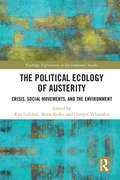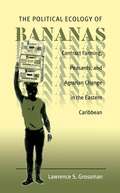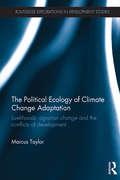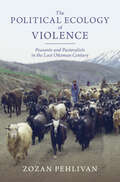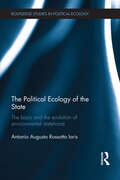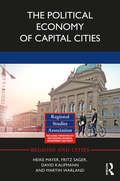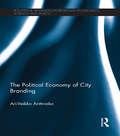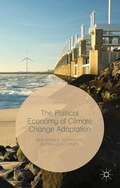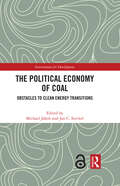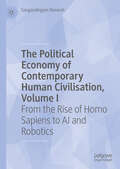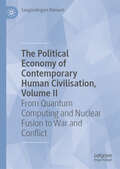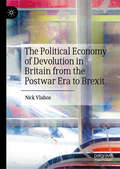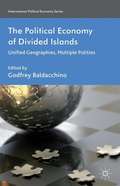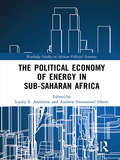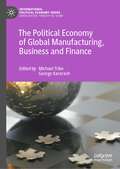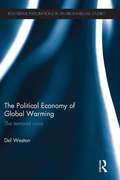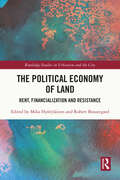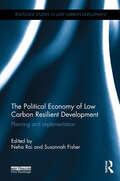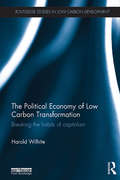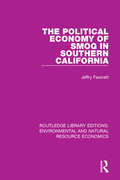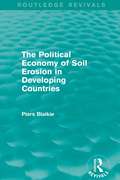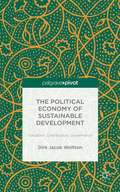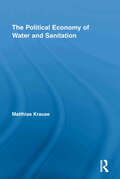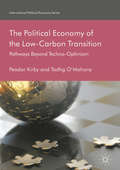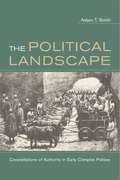- Table View
- List View
The Political Ecology of Austerity: Crisis, Social Movements, and the Environment (Routledge Explorations in Environmental Studies)
by Maria Kaika Rita Calvário Giorgos VelegrakisThe Political Ecology of Austerity explores the environmental dimension of austerity that has thus far escaped academic, policy, and media attention. Offering a better comprehension of the full socio-environmental impact of austerity measures, the book highlights the importance of considering environmental issues when designing responses to economic crisis in the future. Mobilising detailed case studies from across the world, the volume documents the ways in which austerity impacts global and local ecologies, shapes environmental conflicts and gives rise to new forms and practices of social moblisation and resistance. Bringing together theoretical debates and rigorous case studies, the book proposes ‘the political ecology of austerity’ as an appropriate method of analysis that can inform our understanding of the shift in environmental protection policies and the intensification of growth practices (green or otherwise) that followed the 2008 global economic crisis. The Political Ecology of Austerity discloses austerity to be a globalised set of tools not only for budgetary discipline, but also for socio-environmental discipline that justifies the continuation of capital accumulation at the expense of further global environmental degradation. This book will be of great interest to students and scholars of social and political sciences, environmental studies, urban studies, and political ecology.
The Political Ecology of Bananas
by Lawrence S. GrossmanThis study of banana contract farming in the Eastern Caribbean explores the forces that shape contract-farming enterprises everywhere--capital, the state, and the environment. Employing the increasingly popular framework of political ecology, which highlights the dynamic linkages between political-economic forces and human-environment relationships, Lawrence Grossman provides a new perspective on the history and contemporary trajectory of the Windward Islands banana industry. He reveals in rich detail the myriad impacts of banana production on the peasant laborers of St. Vincent and the Grenadines. Grossman challenges the conventional wisdom on three interrelated issues central to contract farming and political ecology. First, he analyzes the process of deskilling and the associated significance of control by capital and the state over peasant labor. Second, he investigates the impacts of contract farming for export on domestic food production and food import dependency. And third, he examines the often misunderstoodproblem of pesticide misuse. Grossman's findings lead to a reconsideration of broader debates concerning the relevance of research on industrial restructuring and globalization for the analysis of agrarian change. Most important, his work emphasizes that we must pay greater attention to the fundamental significance of the "environmental rootedness" of agriculture in studies of political ecology and contract farming.
The Political Ecology of Climate Change Adaptation: Livelihoods, agrarian change and the conflicts of development (Routledge Explorations in Development Studies)
by Marcus TaylorThis book provides the first systematic critique of the concept of climate change adaptation within the field of international development. Drawing on a reworked political ecology framework, it argues that climate is not something ‘out there’ that we adapt to. Instead, it is part of the social and biophysical forces through which our lived environments are actively yet unevenly produced. From this original foundation, the book challenges us to rethink the concepts of climate change, vulnerability, resilience and adaptive capacity in transformed ways. With case studies drawn from Pakistan, India and Mongolia, it demonstrates concretely how climatic change emerges as a dynamic force in the ongoing transformation of contested rural landscapes. In crafting this synthesis, the book recalibrates the frameworks we use to envisage climatic change in the context of contemporary debates over development, livelihoods and poverty. With its unique theoretical contribution and case study material, this book will appeal to researchers and students in environmental studies, sociology, geography, politics and development studies.
The Political Ecology of Violence: Peasants and Pastoralists in the Last Ottoman Century (Studies in Environment and History)
by Zozan PehlivanIn this innovative, interdisciplinary work, Zozan Pehlivan presents a new environmental perspective on inter-communal conflict, rooting slow violence in socio-economic shifts and climatic fluctuations. From the nineteenth to the early twentieth centuries, recurrent and extreme climate disruptions became an underlying yet unacknowledged component of escalating conflict between Christian Armenian peasants and Muslim Kurdish pastoralists in Ottoman Kurdistan. By the eve of the First World War, the Ottoman state's shifting responses to these mounting tensions transformed the conflict into organized and state-sponsored violence. Pehlivan upends the 'desert-sown' thesis, and establishes a new theoretical and conceptual framework drawing on climate science, agronomy, and zoology. From this alternative vantage point, Pehlivan examines the impact of climate on local communities, their responses and resilience strategies, arguing that nineteenth-century ecological change had a transformative and antagonistic impact on economy, state and society.
The Political Ecology of the State: The basis and the evolution of environmental statehood (Routledge Studies in Political Ecology)
by Antonio Augusto IorisThe contemporary state is not only the main force behind environmental change, but the reactions to environmental problems have played a crucial role in the modernisation of the state apparatus, especially because of its mediatory role. The Political Ecology of the State is the first book to critically assess the philosophical basis of environmental statehood and regulation, addressing the emergence and evolution of environmental regulation from the early twentieth century to the more recent phase of ecological modernisation and the neoliberalisation of nature. The state is understood as the result of permanent socionatural interactions and multiple forms of contestation, from a critical politico-ecological approach. This book examines the tension between pro- and anti-commons tendencies that have permeated the organisation and failures of the environmental responses put forward by the state. It provides a reinterpretation of the achievements and failures of mainstream environmental policies and regulation, and offers a review of the main philosophical influences behind different periods of environmental statehood and regulation. It sets out an agenda for going beyond conventional state regulation and grassroots dealings with the state, and as such redefines the environmental apparatus of the state.
The Political Economy of Capital Cities (Regions and Cities)
by David Kaufmann Heike Mayer Fritz Sager Martin WarlandCapital cities that are not the dominant economic centers of their nations – so-called ‘secondary capital cities’ (SCCs) – tend to be overlooked in the fields of economic geography and political science. Yet, capital cities play an important role in shaping the political, economic, social and cultural identity of a nation. As the seat of power and decision-making, capital cities represent a nation’s identity not only through their symbolic architecture but also through their economies and through the ways in which they position themselves in national urban networks. The Political Economy of Capital Cities aims to address this gap by presenting the dynamics that influence policy and economic development in four in-depth case studies examining the SCCs of Bern, Ottawa, The Hague and Washington, D.C. In contrast to traditional accounts of capital cities, this book conceptualizes the modern national capital as an innovation-driven economy influenced by national, local and regional actors. Nationally, overarching trends in the direction of outsourcing and tertiarization of the public-sector influence the fate of capital cities. Regional policymakers in all four of the highlighted cities leverage the presence of national government agencies and stimulate the economy by way of various locational policy strategies. While accounting for their secondary status, this book illustrates how capital-city actors such as firms, national, regional and local governments, policymakers and planning practitioners are keenly aware of the unique status of their city. The conclusion provides practical recommendations for policymakers in SCCs and highlights ways in which they can help to promote economic development.
The Political Economy of City Branding (Routledge Advances in Regional Economics, Science and Policy #2)
by Ari-Veikko AnttiroikoGlobalization affects urban communities in many ways. One of its manifestations is increased intercity competition, which compels cities to increase their attractiveness in terms of capital, entrepreneurship, information, expertise and consumption. This competition takes place in an asymmetric field, with cities trying to find the best possible ways of using their natural and created assets, the latter including a naturally evolving reputation or consciously developed competitive identity or brand. The Political Economy of City Branding discusses this phenomenon from the perspective of numerous post-industrial cities in North America, Europe, East Asia and Australasia. Special attention is given to local economic development policy and industrial profiling, and global city rankings are used to provide empirical evidence for cities’ characteristics and positions in the global urban hierarchy. On top of this, social and urban challenges such as creative class struggle are also discussed. The core message of the book is that cities should apply the tools of city branding in their industrial promotion and specialization, but at the same time take into account the special nature of their urban communities and be open and inclusive in their brand policies in order to ensure optimal results. This book will be of interest to scholars and practitioners working in the areas of local economic development, urban planning, public management, and branding.
The Political Economy of Climate Change Adaptation
by Benjamin K. Sovacool Björn-Ola LinnérThe Political Economy of Climate Change Adaptation.
The Political Economy of Coal: Obstacles to Clean Energy Transitions (Environment for Development)
by Michael JakobThis volume provides an overview of the political economy of coal in diverse country contexts. Coal is the largest source of greenhouse gas emissions globally, accounting for about 40 percent of energy-related CO2 emissions. Continued construction of coal-fired power plants could make the climate targets of the Paris Agreement infeasible to achieve. In spite of sharply declining costs for renewable energy sources, many countries still heavily rely on coal to meet their energy demand. The predominance of coal can only be adequately understood in light of the political factors that determine energy policy formulation. To this end, this edited volume assembles a wide variety of case studies exploring the political economy of coal for across the globe. These includes industrial and developing nations, coal importers and exporters as well as countries that are either substantial coal users, are just beginning to ramp up their capacities, or have already initiated a coal phase-out. Importantly, all case studies are structured along a unifying framework that focuses on the central actors driving energy policy formulation, their main objectives as well as the context that determines to what extent they can influence policy making. This large set of comparable studies will permit drawing conclusions regarding key similarities as well as differences driving coal use in different countries. This book will be of great interest to students and scholars of energy, climate change, resource management, and sustainable development. It will also appeal to practitioners and policymakers involved in sustainable development.
The Political Economy of Contemporary Human Civilisation, Volume I: From the Rise of Homo Sapiens to AI and Robotics
by Sangaralingam RameshThis book, the first of two volumes, examines the evolution of humanity and development global economic systems to provide insight into the advances and challenges they have created. By placing modern technology and global crises within the context of long-term human development, it evaluates the threat of climate change on future generations by showing how past civilizations have survived and succumbed to climate events. A similar approach is taken with migration, where the current migration crisis is contrasted against historic migration patterns. The potential for artificial intelligence, quantum computing, nuclear fusion, and biotechnology to combat these challenges, as well as tackle poverty and inequality, are also discussed. This book highlights the consequences of human cognition and the constant desire for economic growth and evaluates whether they have been a net positive for human society. It will be of interest to students and researchers working on political economy and global challenges.
The Political Economy of Contemporary Human Civilisation, Volume II: From Quantum Computing and Nuclear Fusion to War and Conflict
by Sangaralingam RameshThis book, the second of two volumes, examines the evolution of humanity and development global economic systems to provide insight into the advances and challenges they have created. By placing modern technology and global crises within the context of long-term human development, it evaluates the threat of climate change on future generations by showing how past civilizations have survived and succumbed to climate events. The potential for artificial intelligence, quantum computing, nuclear fusion, and biotechnology to combat the current global challenges is explored, alongside possibilities of new technologies exacerbating poverty, inequality, and social division. This book highlights the consequences of human cognition and the constant desire for economic growth and evaluates whether they have been a net positive for human society. It will be of interest to students and researchers working on political economy and global challenges.
The Political Economy of Devolution in Britain from the Postwar Era to Brexit
by Nick VlahosThis book examines the political economy of devolution in Britain from the postwar period to the present. It situates devolution in Britain within an understanding of the partisan recalibration of political, economic and democratic scales (or levels) of the state. The author utilizes various explanatory tools to unpack complex social, economic, spatial and political phenomena across national, regional and local scales. The book further contributes to our conceptual understanding of decentralization as a broader, comparative, phenomenon. Particular emphasis is placed on examining why decentralization and devolution occur at particular points in time, which enables the investigation into how political and fiscal powers are (re)organized at different levels of the state.
The Political Economy of Divided Islands
by Godfrey BaldacchinoThe authors investigate the exceptional political economy of the ten inhabited islands whose territory is divided amongst two or more countries: that are unitary geographical spaces but fragmented polities.
The Political Economy of Energy in Sub-Saharan Africa (Routledge Studies on the Political Economy of Africa)
by Lucky E. Asuelime Andrew Emmanuel OkemA deepening ecological crisis is rearing its head in sub-Saharan Africa, as it faces a myriad of challenges in regards to the development of its energy sector. The ‘dirty now and clean up later’ approach to the environment has a strong appeal, particularly because it is often thought of as the last place to try to edge in another priority - especially if that priority is perceived by many to be an economic luxury. Asuelime and Okem bring together a team of specialist contributors who investigate to what extent sub-Saharan Africa has displayed foresight or politico-economic integrity. The book shows the state’s ability to meet the demands of provision of energy in sub-Saharan Africa has led to heavy investments in infrastructure, transmission and distribution of energy to the citizens. However, the inefficiencies, corruption and unhealthy bureaucratic challenges that accompany this have led urgent problems, which will be thoroughly explored in this book. The Political Economy of Energy in Sub-Saharan Africa will be of interest to students and scholars of African Studies, Development Studies, political science and environment.
The Political Economy of Global Manufacturing, Business and Finance (International Political Economy Series)
by George Kararach Michael TribeThis book is written as a tribute to Frederick Nixson’s extensive work on industrial development in the Global South, while seeking to actively engage with the latest arguments concerning development economics, together with changes in manufacturing and industrial policy that continue to shape the role of the Global South in the international economy, the impact of the increased concentration of global multinational corporations in that space, along with the rise of new financing tools and debt traps. The chapters pay homage to Fred’s broad view of the international development process and reflect his breadth of perception both theoretically and geographically. The book targets both the scholarly and policymaking audience.
The Political Economy of Global Warming: The Terminal Crisis (Routledge Explorations in Environmental Studies)
by Del WestonHumanity is facing an unprecedented global catastrophe as a result of global warming. This book examines the reasons why international agencies, together with national governments, are seemingly unable to provide real and binding solutions to the problems. The reasons presented relate to the existing dominant global economic structure of capitalism as well as the fact that global warming is too often seen as an isolated problem rather than one of a suite of exceptional, converging and accelerating crises arising from the global capitalist political economy. <P><P> This book adopts a political economy framework to address these issues. It accepts the science of global warming but challenges the predominant politics and economics of global warming. To illustrate the key issues involved, the book draws on South Africa – building on Samir Amin’s thesis that the country represents a microcosm of the global political economy. By taking a political economy approach, the book provides a clear explanation of the deep and pervasive problem of the denial which fails to acknowledge global warming as a systemic rather than a market problem. The book should be of interest to students and scholars researching climate change, environmental politics, environmental and ecological economics, development studies and political economics.
The Political Economy of Land: Rent, Financialization and Resistance (Routledge Studies in Urbanism and the City)
by Robert Beauregard Mika HyötyläinenRecent years have seen a gathering interest in the importance of real estate development to the growth and development of cities. This has included theoretical work on such topics as land rent and property rights as well as empirical studies on property investments, assetization, securitization, and the effects of changing property values on economic growth and the global status of cities. In the field of urban political economy, attention has turned particularly to the financialization of land and the built environment and to the globalization of property ownership, real estate development, and architectural design. This edited volume brings together a collection of original investigations of the current thinking on three broad themes: the assetization of land and buildings, the relationship of land rent to valuation and speculation in the markets for private and public properties, and the different ways in which land functions as a social relation. In order to ground the discussion, each chapter combines a theoretical perspective with empirical evidence. And, to convey a sense of the global nature of these phenomena, the book includes cases from Finland, India, Spain, Singapore, Hong Kong, Japan, Italy, China, and the United States. Although its prime goal is to solidify and extend the political economy of land, the book is also a celebration of the Finnish scholar Anne Haila who was a major contributor to this literature and, specifically, to the work of the book’s authors. Prior to her sudden death in 2019, she was a key figure in the discussions that are at the core of the political economy of land: the book, in part, is a public acknowledgement of her contributions.
The Political Economy of Low Carbon Resilient Development: Planning and implementation (Routledge Studies in Low Carbon Development)
by Susannah Fisher Neha RaiOver the last decade, policies and financing decisions aiming to support low carbon resilient development within the least developed countries have been implemented across several regions. Some governments are steered by international frameworks, such as the UN Framework Convention on Climate Change (UNFCCC), while others take their own approach to planning and implementing climate resilient actions. Within these diverse approaches however, there are unspoken assumptions and normative assessments of what the solutions to climate change are, who the most appropriate actors are and who should benefit from these actions. This book examines the political economy dynamics or the underlying values, knowledge, discourses, resources and power relationships behind decisions that support low carbon resilient development in the least developed countries. While much has been written on the politics of climate change, this book will focus on the political economy of national planning and the ways in which the least developed countries are moving from climate resilient planning to implementation. The book will use empirical evidence of low carbon resilient development planning in four countries: Bangladesh, Ethiopia, Rwanda and Nepal. Different approaches to low carbon resilience are critically analysed based on detailed analysis of key policy areas. This book will be of great interest to policy makers, practitioners’ students and scholars of climate change and sustainable development.
The Political Economy of Low Carbon Transformation: Breaking the habits of capitalism (Routledge Studies in Low Carbon Development)
by Harold WilhiteDeep reductions in energy use and carbon emissions will not be possible within political economies that are driven by the capitalist imperatives of growth, commodification and individualization. As such, it has now become necessary to understand the relationship between capitalism and the emergence of high energy habits. Using the examples of home energy, transport and food, The Political Economy of Low Carbon Transformation articulates the relationship between the politics of economic expansion and the formation of high-energy habits at the level of family and household. The book elaborates a theory of habit and how it can contribute to this relationship. It critiques mainstream green economy and green energy prescriptions for low carbon transformation that take economic growth for granted and ignore habits formed in a material world designed and built for high energy use. The book explores the growing number of communities around the world that are engaged in collaborative efforts to reform their community and household habits in ways that are less environmentally intrusive. It assesses their potential to make an impact on national and urban low carbon political agendas. The book is aimed at a large and growing interdisciplinary audience interested in the relationship between political economy, consumption and sustainability.
The Political Economy of Smog in Southern California (Routledge Library Editions: Environmental and Natural Resource Economics)
by Jeffry FawcettThis study, first published in 1990, explores the ways in which institutions can succeed or fail at environmental improvement. The author first takes a look at the nature of environmental politics and the history of air pollution control in Southern California. He then develops a political economic model that asks the question: what effect have the dramatic changes that have occurred throughout the history of air pollution control in Southern California had on air quality? Jeffry Fawcett uses the information gathered to both evaluate the relationship between air quality and institutional change; and to evaluate how political economists explain how state environmental institutions work. This title will be of interest to students of environmental economics and policy.
The Political Economy of Soil Erosion in Developing Countries
by Piers BlaikieFirst published in 1985. This book examines wide variety of ways in which environmental deterioration, in particular soil erosion, can be viewed and the implicit political judgements that often inform them. Using the context of developing countries, where the effects tend to be more acute due to underdevelopment and climatic factors, this work aims to examine this source of uncertainty and make explicit the underlying assumptions in the debate about soil erosion. It also rejects the notion that soil erosion is a politically neutral issue and argues that conservation requires fundamental social change. This title will be of interest to students of environmental and developmental studies.
The Political Economy of Sustainable Development: Valuation, Distribution, Governance
by Dirk Jacob WolfsonThe author shows how sustainable development may be organized, valued and distributed by introducing situational contracting as an interactive and contextual mode of governance. Situational contracting provides a road map for where we want to go, serving the prevailing ideology in implementing the trade between efficiency and fairness.
The Political Economy of Water and Sanitation (Routledge Studies in Development and Society #Vol. 20)
by Matthias KrauseAccording to recent estimates, around 6,000 people – mostly children under five – die every day from diseases caused by inappropriate water and sanitation (WS) services. Much of the academic and political debate surrounding this issue has focused on private sector participation. By shifting the attention towards the influence of governance, Krause examines the political and sectoral institutions that are essential for the provision of WS services. Utilizing data from sixty-nine developing countries, Matthias Krause demonstrates that the level of democracy has a statistically significant positive impact on access to WS services and that low-quality governance of sub-national governments compromises the internal efficiency of providers and the widespread access to services. This book makes a critical contribution to the water and sanitation research and will help academics and policy-makers to rethink the way in which they deal with water issues.
The Political Economy of the Low-Carbon Transition
by Peadar Kirby Tadhg O’mahonyThis book addresses the global need to transition to a low-carbon society and economy by 2050. The authors interrogate the dominant frames used for understanding this challenge and the predominant policy approaches for achieving it. Highlighting the techno-optimism that informs our current understanding and policy options, Kirby and O'Mahony draw on the lessons of international development to situate the transition within a political economy framework. Assisted by thinking on future scenarios, they critically examine the range of pathways being implemented by both developed and developing countries, identifying the prevailing forms of climate capitalism led by technology. Based on evidence that this is inadequate to achieve a low-carbon and sustainable society, the authors identify an alternative approach. This advance emerges from community initiatives, discussions on postcapitalism and debates about wellbeing and degrowth. The re-positioning of society and environment at the core of development can be labelled "ecosocialism" - a concept which must be tempered against the conditions created by Trumpism and Brexit.
The Political Landscape: Constellations of Authority in Early Complex Polities
by Adam T. SmithHow do landscapes--defined in the broadest sense to incorporate the physical contours of the built environment, the aesthetics of form, and the imaginative reflections of spatial representations--contribute to the making of politics? Shifting through the archaeological, epigraphic, and artistic remains of early complex societies, this provocative and far-reaching book is the first systematic attempt to explain the links between spatial organization and politics from an anthropological point of view. The Classic-period Maya, the kingdom of Urartu, and the cities of early southern Mesopotamia provide the focal points for this multidimensional account of human polities. Are the cities and villages in which we live and work, the lands that are woven into our senses of cultural and personal identity, and the national territories we occupy merely stages on which historical processes and political rituals are enacted? Or do the forms of buildings and streets, the evocative sensibilities of architecture and vista, the aesthetics of place conjured in art and media constitute political landscapes--broad sets of spatial practices critical to the formation, operation, and overthrow of polities, regimes, and institutions? Smith brings together contemporary theoretical developments from geography and social theory with anthropological perspectives and archaeological data to pursue these questions.
